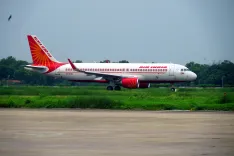How is Middle East air travel affected by US strikes on Iran?

Synopsis
Key Takeaways
- U.S. airstrikes have led to significant air travel disruptions.
- Airlines are avoiding high-risk airspace to ensure safety.
- Flight delays and higher costs are impacting travelers.
- Regional tensions are escalating with missile and drone threats.
- Thousands of tourists are stranded, requiring urgent evacuation.
New Delhi, June 22 (NationPress) The landscape of air travel in the Middle East is experiencing significant upheaval following the recent airstrikes by the United States on Iranian nuclear sites this past Sunday.
Due to escalating security fears, airlines are actively avoiding extensive sections of the region's airspace. This has resulted in flight delays, extended travel durations, and rising operational costs.
Flight tracking service FlightRadar24 reports that many commercial aircraft are being rerouted to steer clear of nations such as Iran, Iraq, Syria, and Israel.
Instead, airlines are opting for longer routes over safer territories, including the Caspian Sea, Egypt, or Saudi Arabia.
This alteration in flight patterns is causing increased fuel usage and escalating flight expenses.
“In light of the U.S. strikes, commercial aviation is continuing to avoid high-risk regions, adhering to the airspace restrictions that were established last week,” FlightRadar24 stated on the social media platform X.
The regional atmosphere remains fraught with tension, highlighted by a rise in missile and drone attacks. Safe Airspace, a group monitoring aviation risks, cautioned that the U.S. strikes may elevate risks for American airlines operating near the Middle East.
While no direct threats to civilian flights have been reported yet, the organization suggests that Iran could retaliate by targeting U.S. military installations or leveraging its allies, such as Hezbollah.
Furthermore, Safe Airspace has indicated that other Gulf states, including Bahrain, Kuwait, Oman, Qatar, Saudi Arabia, and the United Arab Emirates, might also encounter heightened threats.
The group has advised airlines to exercise utmost caution. In Israel, major carriers such as El Al, Arkia, and Israir have ceased operating rescue flights intended to bring Israeli citizens back home.
El Al has also announced that regular commercial flights will remain suspended until at least June 27.
Israeli airspace is currently closed, although land borders with Jordan and Egypt remain accessible.
This conflict has left thousands stranded; nearly 40,000 foreign tourists in Israel are attempting to depart, with many aiming to cross into Jordan by land or reach Cyprus by sea.
Israel’s Tourism Ministry is mobilizing efforts to facilitate their evacuation. Numerous nations have begun to withdraw their citizens.






